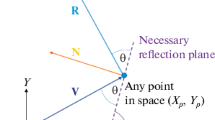Abstract
An experimental muon source (EMuS) will be built at the China Spallation Neutron Source (CSNS). In phase I of CSNS, it has been decided that EMuS will provide a proton beam of 5 kW and 1.6 GeV to generate muon beams. A 128-channel muon spin rotation/relaxation/resonance (μSR) spectrometer is proposed as a prototype surface muon spectrometer in a sub-branch of EMuS. The prototype spectrometer includes a detection system, sample environment, and supporting mechanics. The current design has two rings located at the forward and backward directions of the muon spin with 64 detectors per ring. The simulation shows that the highest asymmetry of approximately 0.28 is achieved by utilizing two 10-mm-thick brass degraders. To obtain the optimal asymmetry, the two-ring structure is updated to a four-ring structure with 32 segments in each ring. An asymmetry of 0.42 is obtained through the simulation, which is higher than that of all the current μSR spectrometers in the world.










Similar content being viewed by others
References
P. Dalmas de Réotier, A. Yaouanc, Muon spin rotation and relaxation in magnetic materials. J. Phys.: Condens. Matter 9, 9113–9166 (1997). https://doi.org/10.1088/0953-8984/9/43/002
J.E. Sonier, μSR brochure (2002). http://musr.net/muSRBrochure.pdf
P.J.C. King, R. Renzi, S.P. Cottrell et al., ISIS muons for materials and molecular science studies. Phys. Scr. 88, 068502 (2013). https://doi.org/10.1088/0031-8949/88/06/068502
F. Foroughi, E. Morenzoni, T. Prokscha et al., Upgrading the PSI muon facility. Hyperfine Interact. 138, 483–488 (2001). https://doi.org/10.1023/A:1020830830050
R. Xiao, E. Morenzoni, Z. Salman et al., A segmented conical electric lens for optimization of the beam spot of the low-energy muon facility at PSI: a Geant4 simulation analysis. Nucl. Sci. Tech. 28, 29 (2017). https://doi.org/10.1007/s41365-017-0190-2
J.L. Beveridge, J. Doornbos, D.M. Garner, Muon facilities at TRIUMF. Hyperfine Interact. 32, 907–912 (1986). https://doi.org/10.1007/BF02395002
A.D. Hillier, M. Aramini, P.J. Baker et al., Developing the Muon Facilities at ISIS, in Proceedings of the 14th International Conference on Muon Spin Rotation, Relaxation and Resonance (μSR2017), Sapporo, Japan, 25–30 June 2017. https://doi.org/10.7566/JPSCP.21.011055
Y. Miyake, K. Shimomura, N. Kawamura et al., Current status of the J-PARC muon facility, MUSE, Paper presented at the 13th International Conference on Muon Spin Rotation, Relaxation and Resonance, Grindelwald, Switzerland, 1–6 June 2014. https://doi.org/10.1088/1742-6596/551/1/012061
A. Sato, Y. Kuno, H. Sakamoto et al., MuSIC, the world’s highest intensity DC muon beam using a pion capture system, in Conference proceedings of the 2nd International Particle Accelerator Conference (IPAC), San Sebastian, Spain, 4-9 September 2011. http://accelconf.web.cern.ch/AccelConf/IPAC2011/papers/MOPZ001.PDF
J.Y. Tang, S.N. Fu, J. Wei, Characteristics and potential applications of the proton beams at the CSNS. J. Korean Phys. Soc. 52, 710–713 (2008). https://doi.org/10.3938/jkps.52.710
H.T. Jing, C. Meng, J.Y. Tang et al., Production target and muon collection studies for an experimental muon source at CSNS. Nucl. Instrum. Meth. A 684, 109–116 (2012). https://doi.org/10.1016/j.nima.2012.05.045
R. Xiao, Y.F. Liu, X.J. Ni et al., Spin polarization and production rate studies of surface muons in a novel solenoid capture system based on CSNS. Nucl. Sci. Tech. 28, 109 (2017). https://doi.org/10.1007/s41365-017-0261-4
E. Won, A proposal muon facility in RAON/Korea, in Proceedings of the International Symposium on Science Explored by Ultra Slow Muon (USM213), Matsue, Shimane, Japan, 9–12 August 2014. https://doi.org/10.7566/JPSCP.2.010110
J.Y. Tang, X.J. Ni, X.Y. Ma et al., EMuS muon facility and its application in the study of magnetism. Quantum Beam Sci. 2, 23 (2018). https://doi.org/10.3390/qubs2040023
K.M. Kojima, T. Murakami, T. Takahashi et al., New μSR spectrometer at J-PARC MUSE based on Kalliope detectors. Paper presented at the 13th International Conference on Muon Spin Rotation, Relaxation and Resonance, Grindelwald, Switzerland, 1–6 June 2014. https://doi.org/10.1088/1742-6596/551/1/012063
K. Sedlak, R. Scheuermann, T. Shiroka et al., MuSRSim and MusrSimAna—Simulation Tools for μSR Instruments. Phys. Procedia 30, 61–64 (2012). https://doi.org/10.1016/j.phpro.2012.04.040
S. Agostinelli et al., Geant4—a simulation toolkit. Nucl. Instrum. Meth. A 53, 250–303 (2003). https://doi.org/10.1016/S0168-9002(03)01368-8
R. Brun, F. Rademakers, ROOT—an object-oriented data analysis framework. Nucl. Instrum. Meth. A 389, 81–86 (1997). https://doi.org/10.1016/S0168-9002(97)00048-X
S.R. Giblin, S.P. Cottrell, P.J.C. King et al., Optimising a muon spectrometer for measurements at the ISIS pulsed muon source. Nucl. Instrum. Meth. A 751, 70–78 (2014). https://doi.org/10.1016/j.nima.2014.03.010
T.J. Roberts, D.M. Kaplan, G4beamline simulation program for matter-dominated beam lines. Paper presented at 2007 IEEE Particle Accelerator Conference (PAC), Albuquerque, NM, USA, 25–29 June 2007. https://doi.org/10.1109/PAC.2007.4440461
Nagamine, K, Introductory Muon Science. (Cambridge University Press, Cambridge, 2003), pp. 11–12. https://doi.org/10.1017/CBO9780511470776.002https://doi.org/10.1017/CBO9780511470776.002
Z. Pan, X. Ni, B. Ye, Conceptual design of MuSR spectrometer for EMuS using Monte Carlo simulation, in Conference proceedings of 3rd China-Japan Joint Workshop on Positron Science (JWPS2017), Hefei, China, 8–10 June 2017. https://doi.org/10.7567/JJAPCP.7.011303
R.J. da Silva Afonso, P.J. Baker, J.S. Lord, et al, Monte Carlo simulations of the MuSR spectrometer at ISIS: current instrument and future designs. (STFC ePubs website, 2001) https://nmi3.eu/index.php?get_file=monte_carlo_simulations_of_the_musr_spectrometer_at_isis.pdf. Accessed 10 April 2019
Stephen Cottrell, Chinese Detector Tests, STFC ISIS Neutron and Muon Source, 2018. https://doi.org/10.5286/ISIS.E.RB1830641
Author information
Authors and Affiliations
Corresponding author
Additional information
This work was supported by the National Natural Science Foundation of China (No. 11527811) and the Key Program of State Key Laboratory of Particle Detection and Electronics. A part of the work performed in the UKRI ISIS Detector Group was sponsored by the China Scholarship Council.
Rights and permissions
About this article
Cite this article
Pan, ZW., Dong, JY., Ni, XJ. et al. Conceptual design and update of the 128-channel μSR prototype spectrometer based on musrSim. NUCL SCI TECH 30, 123 (2019). https://doi.org/10.1007/s41365-019-0648-5
Received:
Revised:
Accepted:
Published:
DOI: https://doi.org/10.1007/s41365-019-0648-5



